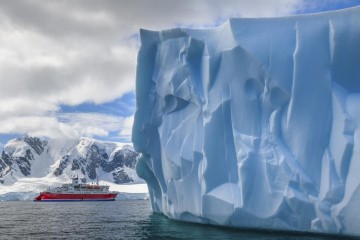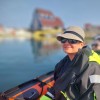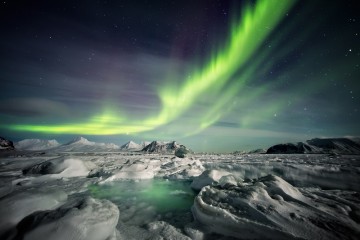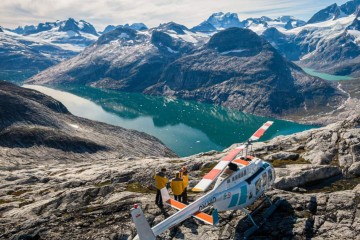Both the Arctic and Antarctica offer unique and awe-inspiring experiences. Although they may seem similar at first glance – with their sweeping harsh landscapes and incredible wildlife – they are distinct regions with quite different characteristics.
Choosing which polar region to visit on an expedition cruise will depend on several factors: not only your interests and preferences but also the time of year you wish to travel.
To help you figure out which extreme destination is better suited to you, we’ll first give an overview of each region and then highlight the main distinctions of visiting either one on expedition cruises.
An introduction, to get your bearings:
Arctic vs Antarctica - the main differences you'll notice on an expedition cruise:
Overview of the Arctic
The Arctic is often considered more accessible, especially for those in the northern hemisphere. However, if you're from Australia or New Zealand, check out the 'How to Get There' section for a relative overview.
Arctic destinations include:
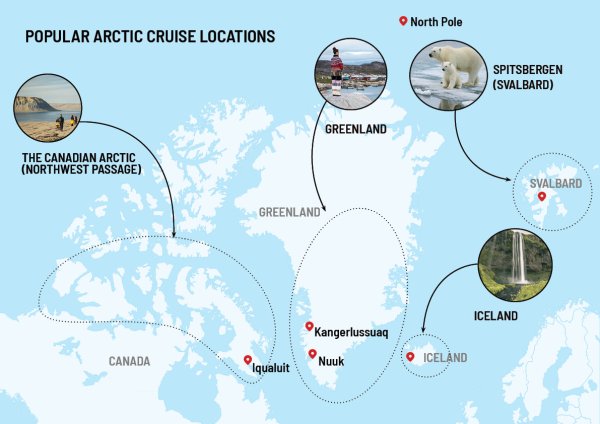
While the Arctic boasts greater diversity of wildlife species compared to Antarctica (from polar bears to walruses, musk oxen, seals, whales, and various bird species) the overall wildlife-watching experience is less intense.
Cultural experiences are a bonus, however, with indigenous communities and unique town centres in just about every Arctic cruise destination. Expedition cruises offer the chance to visit traditional villages and museums, and learn more about the local’s way of life.
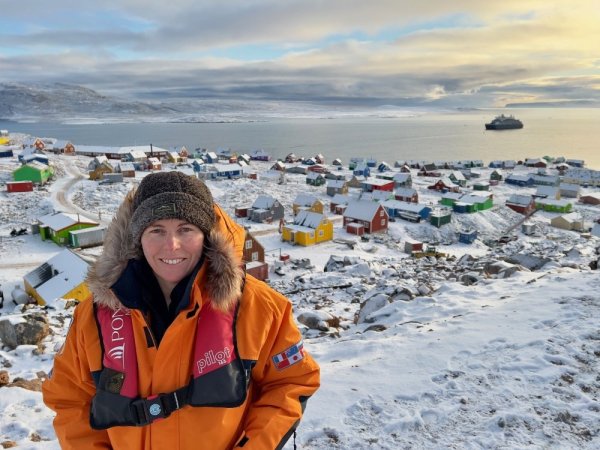
Our Operations Manager, Tara Sutherland, visited this colourful village in Greenland on an Arctic expedition cruise
Despite being an 'extreme' destination, the Arctic is not too isolated and it’s only relatively remote. You're never really far from civilization on an expedition cruise to the Arctic. The climate is also more tempered (within reason) with minimal snow and ice during the northern summer, and average temperatures around 10 degrees Celsius in places like Finland and Iceland.
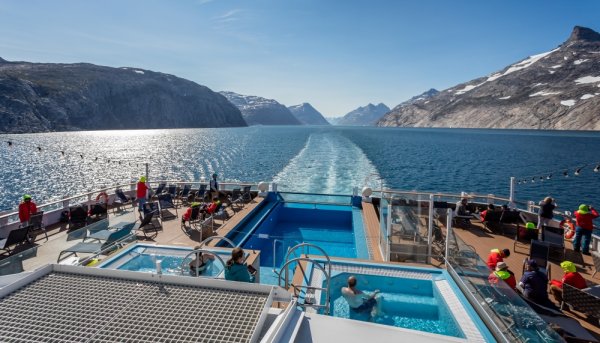
Soaking up the sights of Greenland while soaking in a hot tub!
Overview of Antarctica
Antarctica clinches the gold medal for the most remote and isolated travel destination on Earth, providing unparalleled expedition cruise experiences. As the world's southernmost continent, Antarctica stands out for its pristine and (mostly) untouched environments.
Human activity in Antarctica is minimal and reserved exclusively for scientific research. There are no indigenous people living on the harshest continent on earth, so there are no cultural experiences to be had. If your itinerary does not include visiting a research centre, you won't meet another human soul outside your fellow ship passengers.
Expedition cruises in Antarctica focus on immersing yourself in the splendour of a landscape shaped by nature. Vast ice sheets, towering icebergs, and impressive glaciers form a breathtaking scene, creating an overwhelming and soul-stirring experience for lovers of extreme wilderness.
Overall, Antarctica is a much harsher, colder and more logistically challenging place to visit. Given those extra hurdles, it is generally a little more expensive than the Arctic.
Yet the rewards are awe-inspiring.
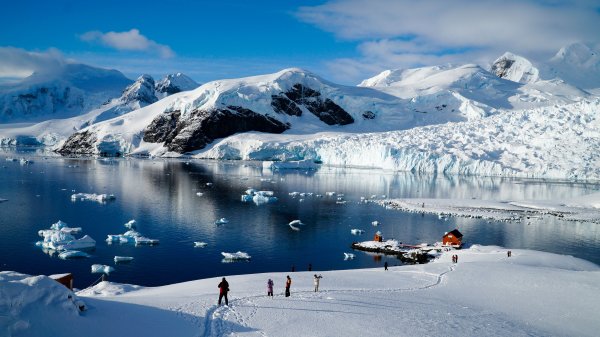
The spellbinding landscapes of Antarctica
The most visited destinations on expedition cruises to Antarctica are:
Arctic vs Antarctica
Landscapes
The sheer fact that humans have been carving out a living in the Arctic for thousands of years – yet none ever settled in Antarctica – tells you that the landscapes of the far north aren’t nearly as harsh and inhospitable as those in the far south. Make no mistake: the scenery in both regions is drop-dead gorgeous. Yet, if you envisage vast expanses of snow and ice on your polar expedition, you will only see that on expedition cruises to Antarctica.
In the Arctic, snowmelt is extensive in the summer months. This glorious mountainous area boasts plenty of snow-covered high peaks, impressive fjords and spellbinding glaciers, but everything at sea level thaws out by the time summer rolls around. The Arctic is one of the biggest losers in our fight against climate change – temperatures are warming up at twice the rate seen elsewhere. Extensive snowmelt in spring is the most significant consequence.
For this reason, the Arctic offers a much greater variety of landscapes and, surprisingly, an incredible array of colours.

Wilderness around Tromso, Norway, the so-called Capital of Arctic explorations in Europe
Naturally, the farther north you travel, the more chances of seeing more ice.
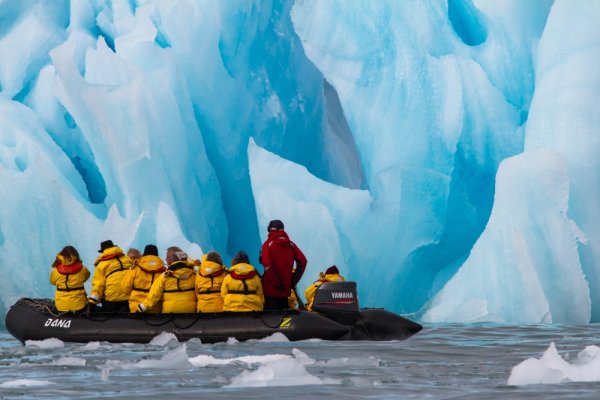
The region around Svalbard is home to fantastical glaciers.
Climate/Weather
Polar regions aren't the most hospitable places by default, but as mentioned earlier, the Arctic tends to have milder climates than Antarctica. During their respective summer seasons when expedition cruises take place, Arctic temperatures typically stay above 0 degrees Celsius, sometimes reaching the low teens. On sunny, windless days, hiking in pants and a T-shirt is possible at lower latitudes, with a parka, scarf, and beanie in a daypack just in case.
Wind plays a crucial role in comfort and the feel of temperatures, making the most pivotal difference between cozy and freezing in both polar regions.
However, Antarctica is notably colder overall. With extensive ice and snow and stronger winds, a 'warm day' on an Antarctica cruise expedition means the temperature barely surpasses freezing (0 degrees Celsius).
Given the unpredictability of polar climates, your packing list for either destination will be identical.
Wildlife
Choosing between Antarctica and the Arctic for a polar expedition cruise can sometimes be as simple as deciding whether you're on "Team Penguins" or "Team Polar Bears."
If you lean towards penguins, then Antarctica is your destination of choice.
Antarctica is renowned for its abundant penguin populations, with hundreds or even thousands visible on an expedition cruise. Most landings take you to penguin rookeries, and special places like South Georgia can offer sightings of tens of thousands of these captivating creatures.
The variety of penguin species and the sheer density of their numbers make Antarctica an extraordinary haven for animal lovers. Witnessing an endless horizon of penguins is an awe-inspiring wildlife spectacle you won't easily forget.
Make sure to pack a wide-lens zoom if visiting South Georgia’s extraordinary King penguin colony
"You really can’t go past South Georgia for its wildlife, witnessing a beach covered with hundreds and thousands of king penguins and some elephant seals in the mix is a sight like no other and as a wildlife lover, it's one of the ultimate experiences in my opinion." - Tara Sutherland, Viva Operations Manager
In contrast, despite hosting a more extensive variety of species, the Arctic doesn't offer as many wildlife sightings. While various animals thrive in the north, observing them in large numbers is uncommon.
"In Antarctica, there is an abundance of wildlife – from whales breaching around the ship to huge colonies of penguins at landing sites and the vastness of being at the end of the earth makes for outstanding landscape photography. In the Arctic it feels like you have to work harder to spot the wildlife, but when you do see it, you get a huge reward! A good pair of binoculars in the Arctic is a must as the wildlife tends to blend into the landscape more than in Antarctica." - Rosemary McNoe, Viva Business Development Manager
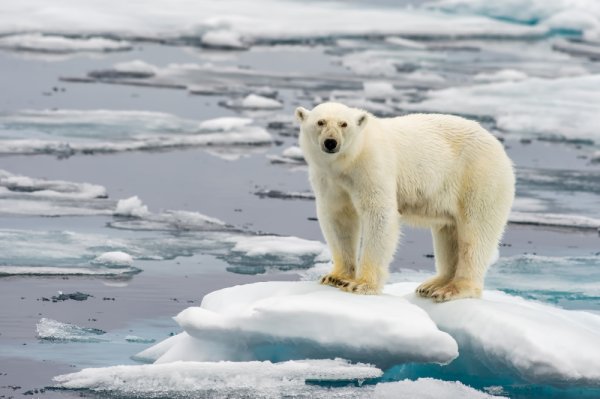
Polar bear sightings in Svalbard are not too rare, yet getting too close to one is highly inadvisable!
Spotting a polar bear on an expedition cruise to the Arctic isn't guaranteed, though choosing itineraries to polar bear hotspots like Svalbard can increase your chances. Apart from polar bears, the Arctic is home to musk ox, caribou, reindeer, narwhals, Arctic foxes, and walruses, along with a great variety of unique seabirds. Narwhals and walruses are particularly rare to spot.

The Atlantic Puffin, known as the ‘clown of the sea’ is one of the most coveted bird sightings on European Arctic cruises
Activities & Things to Do
Regardless of your chosen destination, expedition cruises provide numerous fantastic outdoor activities. Kayaking is immensely popular in both the Arctic and Antarctica, allowing visitors to paddle alongside enormous icebergs in Antarctica and deep fjords in the Arctic. The polar plunge is a right of passage on both Arctic and Antarctic expedition cruises.
Daily landings in Antarctica often revolve around visiting and photographing penguin rookeries, while in the Arctic, activities could include hiking a trail or exploring a traditional village or museum.
Specialized ships and itineraries in Antarctica might offer skiing and overnight camping on ice, providing unique experiences. In the Arctic, activities like dog-sledding on wheels over defrosted terrain might be part of the adventure.
“For an active adventure, I really loved Svalbard, where I got to kayaking through stunning bays near glaciers, take numerous hikes and walks to visit historic huts, to witness grazing reindeer and blooming wildflowers, plus fantastic vistas from hilltops. Plus you have the added bonus of my favourite challenge - a polar plunge, to really get the adrenaline flowing!” - Tara Sutherland, Viva Operations Manager
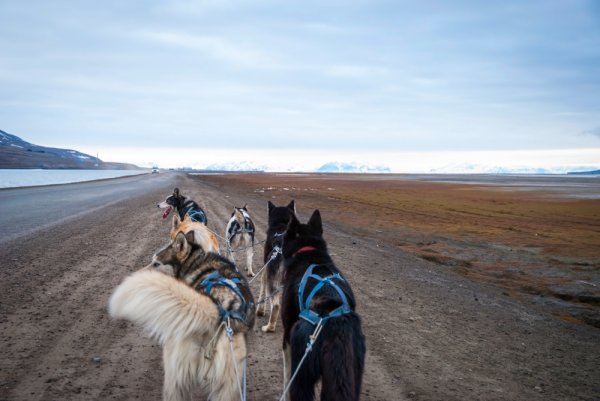
Summer dog sledding excursion, Svalbard
Insider’s Tip: The activities on expedition cruises are significantly influenced by the chosen ship. Some ships are more focused on outdoor adventures than others, so it's crucial to consider this factor when selecting your cruise, regardless of the destination.
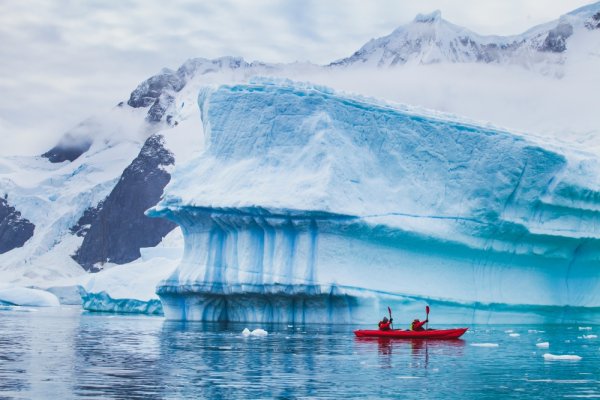
Kayaking alongside icebergs, Antarctica
Seasons & When to Go
The Arctic and Antarctica feature polar opposite seasons – pun intended! The timing of your travels could be the ultimate determinant of which region to explore.
Expedition cruises to the Arctic usually operate from May to August, taking advantage of extensive ice melt that allows ships to reach the remotest northern regions.
In contrast, Antarctica is open for cruising from November to March. Early-season cruising in both destinations offers cold, ice, and snow; mid-season brings 24 hours of daylight, and late-season cruising provides more extensive itineraries and breathtaking sunsets.
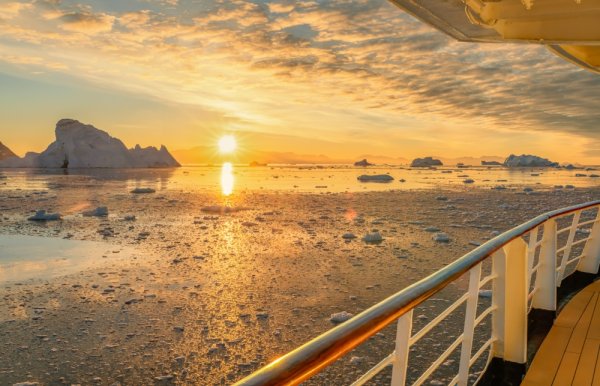
Polar sunsets – a spectacle of nature!
"If I were making a choice based on landscapes and scenery, my favourite has to be Antarctica in the early season, that’s November, when there is lots of snow and ice, and everything is very pristine. I have had days of snowy, moody grey skies, and the odd day of sunshine at this time of year. It makes for spectacular photos, and it's also the perfect time to stay out on deck and just watch the landscapes pass by, late into the evening." - Tara Sutherland, Viva Operations Manager
Trip Length
Arctic and Antarctica expedition cruises typically last around two weeks, with longer voyages available. Arctic cruises, such as those crossing the Northwest Passage, may extend up to 25 days, while Antarctica cruises that half circumnavigate the Peninsula can last around 30 days.
The key difference lies in the time spent at sea. In the Arctic, you can fly directly to the region, board your ship, and commence daily landings and explorations from day 1. On the other hand, reaching Antarctica involves boarding your ship in Ushuaia (South America) and sailing for two full days before reaching the Antarctic region. Once there, daily landings and activities begin in earnest.
The journey across the southern seas, particularly navigating the Drake Passage, is a significant and (for some) unmissable part of the extreme adventure to Antarctica. Despite the advanced technology of expedition ships, crossing this rough body of water remains a unique experience, emphasizing the remoteness and isolation of Antarctica.
Insider’s Tip: If you’re drawn to visiting Antarctica but dread the prospect of a two-day passage of the Drake, know that there are fantastic fly + cruise Antarctica options that allow you to skip the passage, joining the cruise once already in Antarctica.
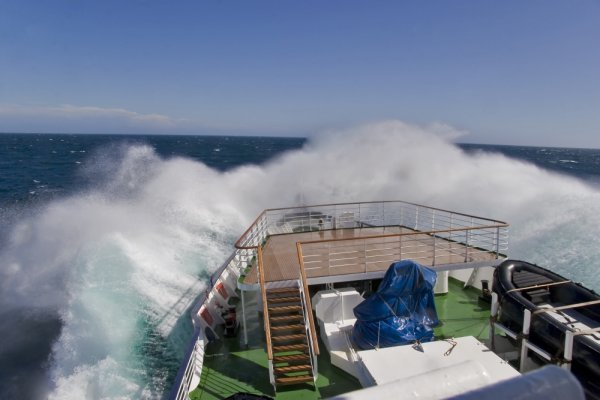
Will you experience a Drake Lake or Drake Shake, on your expedition to Antarctica?
Getting There
Unlike the Arctic, which can be reached via short flight from many major European cities (like Paris, Oslo and Tromsø) and North America (Toronto, Calgary), Antarctica requires more planning.
The most popular port city for Antarctic expedition cruises, Ushuaia, is connected by flight from Buenos Aires (Argentina). American, Delta and United airlines offer non-stop flights to Buenos Aires from North America – the most popular cities being New York, Miami, Dallas, LA and Chicago.
If you're from Australia or New Zealand, there's arguably little difference in the time needed to reach the Arctic or Antarctica. You can fly from Auckland to Buenos Aires via Santiago on LATAM Airlines. You can catch a non-stop Sydney-Santiago QANTAS flight, which takes about 12.5hr. From there, you’ll want an overnight stay before catching an onward flight to Buenos Aires. In the end, you’ll need to factor in 24 hours of travel, door to door – which is the same as flying to Europe in the opposite direction.
Either way, we recommend setting aside at least two travel days to reach Europe, North America or South America.
So, which one should I visit?
If personal preferences were the sole deciding factor, you’d probably choose an expedition to the Arctic for more accessible/shorter adventures, indigenous cultures, on-land hikes and a smattering of unique wildlife. If you’re planning a trip to Europe or North America in the summer, then booking an Arctic expedition makes more sense.
If you're drawn to pristine wilderness, unique landscapes, a more remote and challenging experience, however, not to mention an abundance of penguins of all sizes and waddle styles, an expedition cruise to Antarctica could be the better choice.
Still unsure where to go?
Viva Expeditions' Destination Specialists have cruised the world, from the far north to the far south. They're well-versed in all things related to expedition cruises and know just the right questions to ask to help you determine which one you should visit on an expedition cruise.
Here's a few final thoughts on Arctic vs Antarctic expedition cruises from Tara Sutherland, Viva Operations Manager:
“I have been to Antarctica three times, and to the Arctic twice, so you would think I am a good person to ask – but really its so hard to pick!
My first ever trip to the polar regions was a ‘Classic Antarctica’ itinerary of 11 days departing from Ushuaia, which I did over 18 years ago. This was a very special trip for me, and it got me addicted to polar cruises (even though I get sea sick!), so perhaps this is a good place to start for your first polar experience.”
Will it be Antarctica or the Arctic? One way to find out! Contact us today.
See all Expedition Cruises to the Arctic
See all Expedition Cruises to Antarctica
Laura Pattara
Laura Pattara has spent more than a decade writing about polar cruising at Viva Expeditions. While she has not yet set foot on the southern ice herself, she has mastered the art of turning expert accounts and field notes into guides that feel like the next best thing. Laura has a soft spot for penguins, perfectly packed duffel bags, and a well-earned cocktail in a wild place.
|
